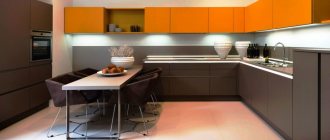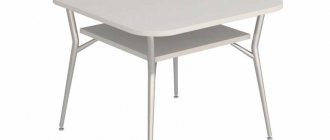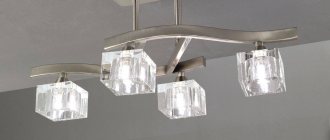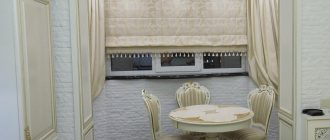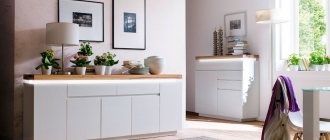Chandeliers are the main element of lighting in various interiors. The kitchen is no exception, although the microclimate here is quite difficult. Designers now often abandon these devices in favor of spotlights and spots, diode strips, and luminous ceilings. But there are still many lovers of the classics, and this will always be the case. The article provides detailed information on how to choose a chandelier for the kitchen depending on size, design, ceiling height and other parameters.
Criteria for choosing a chandelier for the kitchen
High humidity, soot, heat - these are the conditions in this part of the housing. Therefore, lighting fixtures here must meet certain requirements. So, in the kitchen it is better to use lamps and fixtures with protection from dust and moisture with an index of at least IP44.
Model and type of fastening
The following types of chandeliers are distinguished by design:
- Suspended - the lamp is suspended from the ceiling on a cord, chain or stay. Such models are suitable only for a room with a ceiling height of more than 2.5 m. As a rule, a hook is used as a fastening; the wires are hidden under the decorative glass of the lighting fixture. In some products it is possible to adjust the height of the suspension. More often, vertical varieties of chandeliers are used, with shades located on the same line. The growing popularity is due to the fact that the flow of light is more uniform compared to horizontal design.
- Ceiling - devices are attached directly to the concrete floor. They take up less space, so they are more suitable for rooms with low ceilings and are successfully used even in squat rooms of standard panel high-rise buildings. Ceiling chandeliers are mounted on a straight or cross-shaped bar, the wiring is hidden in the device body. The inconvenience of some models is that they have to be partially disassembled to replace the light bulb.
The material from which the device is made is also of enormous importance. After all, in the kitchen the chandelier will have to be washed from soot, even if there is a hood installed above the stove. There is no ideal solution here, but the most convenient to care for are:
- Plastic . Lightweight material, easy to clean and suitable for kitchen conditions. But often plastic fades from the sun, becomes brittle and can break if handled carelessly.
- Metal . Only products coated with powder paint, mastic or other means that protect the surface from corrosion are suitable.
- Glass and crystal . The lampshades are easy to clean and do not react with household chemicals. However, crystal chandeliers are usually made of small parts, and cleaning each one will take a lot of time.
- Wood . Such products are afraid of moisture and temperature changes. Therefore, the surface must be covered with protective compounds - varnish, paint or wax, then you can opt for a wooden model. But there is one more inconvenience: wood absorbs odors. Rattan and matting have similar properties.
Read more: What types of chandeliers are there?
Chandeliers with lampshades made of paper and textiles are absolutely not suitable for the kitchen. They quickly become dirty and cannot be cleaned of soot and grease stains. Even the most powerful ventilation does not solve the problem.
The color should not be easily soiled. You should not choose devices with ornate and complex elements. Washing them is long and inconvenient. It is best to pay attention to the simplest forms.
Chandelier size
Large lighting fixtures look bulky and visually “compress” the space; a cramped room with them seems even smaller. Therefore, the lower the ceilings, the flatter the chandelier you need to choose. And the more compact the area, the smaller the lampshades should be.
The height of the device is determined by dividing the footage from floor to ceiling by 4. But you need to take into account that the distance from the bottom point of the chandelier to the floor must be at least 2 meters, so as not to hit the light bulbs with your head.
The exception is lamps above the dining table. People will not walk here, so the lighting fixture can be lowered lower.
The diameter of the chandelier is calculated using the formula: the width of the room plus the length divided by 10. For example, for a 3x4 m kitchen you need a device with a diameter of 70 cm. However, this calculation is more suitable for square or similar rooms.
Kitchen features
When choosing a chandelier, the shape of the room is taken into account. It can be large, small, elongated, low or tall. The choice of model and location of the lighting fixture depends on this. For example, if you hang a chandelier in the center in a long, narrow kitchen, you will get darker areas in the corners and the level of illumination will be insufficient. The optimal solution in this case would be to use paired companion chandeliers. We will consider this issue in more detail below and give recommendations for each room.
Required degree of illumination
The light from the chandelier should be moderate so as not to blind the eyes, but at the same time bright enough for safe work with cutting tools. For every 10 m², the required norm is the use of light bulbs of the following power:
- incandescent lamps - 120 W;
- halogen - 60 W;
- fluorescent (energy saving) - 30 W;
- light-emitting diode (LED) - 15-20 W.
You can use one or more lighting elements, which together will provide the required power.
A lamp with a light intensity regulator is extremely convenient in the kitchen. It allows you to select the optimal mode depending on the situation, time of day and weather. Another valuable accessory is the remote control, which makes operating the chandelier more convenient, especially in combined kitchen studios.
Interior style
When choosing a model, they also take into account the design style. So, for modern trends, modern, loft, and spider chandeliers are most suitable.
In such a kitchen, both creative design models and laconic and stylish geometry are quite appropriate.
Modern interior is comfort, original furniture. Lampshades in the form of a ball, rhombus, or triangle look beautiful here.
A classic interior is associated with candelabra chandeliers and crystal. But they are quite bulky, so they are installed only in large kitchens, mainly above the dining table.
In Khrushchev such models are superfluous. A large lighting fixture will clutter up the space and visually reduce the height of the ceiling. This option is suitable exclusively for spacious rooms.
For a classic interior of a small area, you can purchase lamps with images or details in the form of flowers.
Floristry also fits well into Provence, shabby chic, and country styles. Flowers perfectly emphasize and complement these directions.
A rustic or hunting lodge will be decorated with a lamp with candle bulbs, metal or wooden parts.
Forged products, imitation of an aged surface like bronze or silver will fit perfectly into this style.
Ethnic lamps are a separate topic, since Japanese, British, African, and oriental styles are distinguished here.
For example, a kitchen in the style of the Land of the Rising Sun requires the use of wooden chandeliers, and Moroccan lamps will complement Arabic interiors.
Laconic Art Nouveau lampshades fit perfectly into high-tech and minimalism. Chandeliers in avant-garde and vintage styles are also chosen here. But products made of plastic, glass, metal, in strict geometric shapes and with a clear, no-frills silhouette are more suitable than others.
Interior design in Provence style is a modest French romance, gentle and sophisticated.
Retro lamps with floral prints and wood details in neutral shades are installed in such a kitchen.
For eco-style, models made from environmentally friendly materials are more suitable than others. These are rattan, driftwood, dry branches. Often lighting fixtures are made by hand. Such chandeliers become interior decoration.
Models reminiscent of street and industrial lamps are selected for the loft. Some of them are quite compact and suitable even for low ceilings.
They are distinguished by rough execution, dominance of metal, aged surfaces, and often the absence of shades. But you can also install classic designs of simple design, lamps made of copper, bronze and other metals, with the exception of gold.
A special approach when planning the interior must be taken if you want to hang a Tiffany chandelier.
It is notable for its stained glass lampshades, which always look like a bright spot in space and massive. Therefore, the remaining finishing elements are selected to match it, and not vice versa. Stained glass chandeliers look most impressive in spacious kitchens.
But all the recommendations described are not an axiom. You can successfully fit a crystal chandelier into a loft, light bulbs without shades into a country style, etc.
Such contrast enlivens the space and adds its own flavor. Different styles look best in spacious rooms. But moderation is important here. You should not combine more than three directions in one interior. But in cramped kitchens it is better to be more restrained in your dreams.
But no matter what style you choose, the color of the chandelier should match the decoration. Designers do not consider it possible to use more than three colors in a room, and the lamp must repeat one of them.
The lampshade can match the kitchen unit, floor, wallpaper or some interior items. Only transparent lampshades are universal, they seem to dissolve in the room. They look great even with bright trim. It is much more difficult to fit catchy models into the interior; when decorating, you will have to build on them.
Lighting brightness
For maximum comfort, the lighting intensity must be sufficient: too bright or dim light will have a depressing effect. To put this into practice, average illumination standards are used for different types of lamps in kitchen lamps. They are 15–20 W/m2 for incandescent lamps, 3–5 W/m2 for fluorescent lamps and 2–3 W/m2 for LED lamps. It is easy to calculate that to illuminate a kitchen, for example, with an area of 10 m2, two 15 W LED bulbs will be required.
Important! The darker the colors used in the interior, the brighter the lamps should shine.
It is also useful to provide the ability to adjust the brightness of the lighting. If during culinary experiments there should be as much light as possible, then during kitchen gatherings, dim light will add coziness and intimacy.
Use a chandelier where you can turn on individual bulbs, or a switch with a dimmer to adjust the intensity of incandescent bulbs: this will add atmosphere to your home and avoid wasting energy.
One of the most important criteria for choosing a kitchen lamp is how well it will look in the interior.
Where is the best place to place a chandelier?
The main light source is always located in the middle of the ceiling. But this rule only applies to a small kitchen. Spacious rooms are usually divided into dining and working areas, and one chandelier is not enough here.
A rectangular and oval table is illuminated with two or three small companion chandeliers at once. They do not have to be absolutely identical, and may differ, for example, in the color of the lampshade. With this lighting, all diners will feel equally comfortable.
Paired devices are also used in another way: one is hung above the table, the second above the bar counter. A fashionable element of a modern kitchen is an island or peninsula. The chandelier can be placed directly above them. Chandelier fans will also come in handy here.
In the dining room, the lighting fixture should be placed no closer than 70 cm to the surface of the tabletop, otherwise the light bulbs will blind the eyes. For the second part, local lighting is used - built-in or overhead spotlights.
A lamp and a chandelier in the kitchen are not the same thing
Now the concept of “chandelier” is attributed to all lighting fixtures on the ceiling. But in fact, a chandelier is a multi-lamp device, and single-lamp devices are lamps. For example, a classic lamp of 4 or more lamps will create general diffused light, i.e. will illuminate the entire kitchen. A single-lamp lamp suspended above a table has a directional luminous flux, i.e. will only illuminate the dining table.
A chandelier is a multi-lamp device for general lighting. The lamp is a single-lamp lamp with a directed luminous flux to one point.
buybuy
An example of a multi-lamp chandelier. Favorite Ultra pendant chandelier
buybuy
An example of a single-lamp lamp. Favorite Ultra pendant lamp
How to choose a chandelier for a non-standard room
The choice of chandelier largely depends on the configuration of the room. The biggest problem we have to face is the small area. Transparent lampshades that seem to dissolve in air will not steal space.
Designers recommend minimalist chandeliers for small kitchens. Even with large sizes, they look neat and compact, do not clutter up the space, and fit into many interior variations.
In the work area, be sure to use lighting under wall cabinets or on the ceiling in the form of spot spots or LED strips. One lamp above the dining table or several neat pendants would also be appropriate here. They should be compact, but not small. In the latter case, the shortcoming will only be emphasized.
There are other problems that affect the choice of lighting fixture:
- Low ceiling . This requires chandeliers with horns facing the top. The lower they are located, the flatter the lampshades should be.
- Narrow elongated rooms . For uniform illumination, you need pendant fixtures with oval or rectangular shades, with lamps at the same level to equally illuminate the entire kitchen area. Proper lighting can also be created with the help of companion chandeliers located closer to narrow walls.
- The rooms are too big . This is also a drawback that makes it difficult to choose lighting. This requires massive hanging chandeliers with numerous arms. An abundance of details will fill the empty space. Additionally, they can be combined with spotlights.
- High ceilings . This kitchen looks uncomfortable. Multi-level models will add comfort, visually reducing the distance to the floor.
Which chandelier to choose for different styles
Depending on the finish, kitchen unit and dining room, several recommendations can be given:
- Laconic kitchen or living room spaces in techno, hi-tech, minimalism or loft styles require discreet solutions: ceiling chandeliers with graphic shapes or pendant lamps imitating street lamps.
- Classic elements in the kitchen interior are emphasized by traditional chandeliers with crystal pendants or in the form of candelabra; lamps with fabric shades will fit into a living room in the style of classicism.
- Ethnic oriental and African motifs go well with lamps reminiscent of traditional crafts. Authentic decor and natural materials will add coziness to both the kitchen eating area and the dining table installed in the living room.
- In an interior in a European spirit (Provence, country, Italian), floral patterns would be appropriate. They can use plant motifs made of glass, metal or plastic, or real branches, dried flowers and leaves, pebbles, shells and other natural materials.
Related article: 3D photo wallpaper on the kitchen wall: from A to Z
Note! Eclecticism techniques and fusion style, which is a mixture of other styles, are always relevant, so not in all cases you need to strive to fit the lamp exactly into the interior. Thus, a richly decorated classic chandelier will emphasize the austere beauty of a kitchen in high-tech or minimalist styles due to contrast.
Recommendations for stretch ceilings
You need to decide on a chandelier for such designs even before stretching the fabric. The need is caused by the finishing features. When installing the frame, special embedded parts are attached to the base floor, to which, after installing the stretch ceiling, a chandelier is mounted.
It should also be taken into account that PVC fabric is afraid of high temperatures. It is better to use suspended models with it or with a metal diffuser to dissipate heat so that the case does not heat up.
The recommended distance from the lamps to the suspended ceiling is at least 20 cm.
Another nuance concerns texture. The glossy canvas reflects everything underneath. Therefore, for such a ceiling it is better to choose a chandelier with arms facing down or with closed shades. Otherwise, glare from the light bulbs will be reflected in the mirror surface and blind your eyes.
Practical materials for kitchen lamps
When choosing a material for a kitchen chandelier, you should be guided by considerations of safety and practicality. Even powerful hoods are not able to protect it from dust and grease droplets, so be prepared for regular cleaning.
Glass, metal and plastic are the most versatile in care, but with natural materials you will have to tinker. If wood can be protected with varnish, and a forged surface with mastic, then fabric and paper will quickly lose their presentable appearance, and they are unlikely to be washed without damaging them. If you are not ready for regular renovations, leave easily stained materials for the bedroom or living room.
The best option is lamps that are protected from splashes and dust; they will extend the life of the light bulbs installed in them, they themselves will last longer and will not require much effort when washing.
It is difficult to choose a chandelier for the kitchen so that it meets all these criteria, so focus on the main thing - the purchase should make you happy.
How to choose the right chandelier (3 videos)
Types of chandeliers and their placement in the kitchen (43 photos)
Nuances of lighting a kitchen combined with a living room
Recently, it has become common to combine rooms to get a larger area and get rid of unnecessary partitions. It is better to hang two chandeliers here, one in the hall, the second in the kitchen. Another option involves delineating zones - working and dining - using several chandeliers located along the conventional border between them.
Experts advise using bright light in the work area and soft light in the sofa area. A chandelier in this part will be a great solution. In addition to overhead lighting, in a living room combined with a kitchen, it is recommended to use an additional floor lamp or miniature sconce lamp.
The space is also zoned using different types of lighting fixtures. For example, a chandelier is hung in the living room, and spotlights are installed in the kitchen. Many options for such combinations are possible.
Scandinavian style
Restrained light colors reign here, with white at the forefront. This style is characterized by neutrality and unobtrusiveness, but at the same time, freedom and a sense of space.
A Scandinavian-style chandelier can be suspended or ceiling-mounted, made of natural wood or metal and should have a laconic, elegant design and simple structure.
Main mistakes when choosing a chandelier
When choosing where to hang a chandelier and which model to choose, beginners often make the following mistakes:
- Location lower than 1.2 m from the tabletop in the dining area. Then the light from the bulbs will be blinding. This not only causes discomfort when eating food, but is also harmful to vision. For greater convenience in the kitchen-living room, you can purchase chandeliers on a telescopic rod or spring, and accurately adjust the height.
- Poor product quality. This is especially true for devices placed above the table. The lampshades are then lowered low, so during a meal it is easy to see even tiny flaws.
- Installation of massive carob and multi-tiered chandeliers in small spaces. They not only clutter and compress space, but also interfere with normal movement.
- Model too small. The problem here is not aesthetics and design, but insufficient power for a large kitchen. If a mistake is made, it can be partially corrected with the help of additional light sources - LED strips, spotlights, sconces, floor lamps, etc.
- The use of dark, opaque shades on the north side and in rooms with gloomy decoration. This visually greatly narrows the space and worsens working conditions.
- The style of the chandelier is the fourth, fifth, etc. in the design of the room. This mix looks sloppy and tastes bad.
- Pendant lights, especially bright colors, in a small room. They visually lower the ceiling and give the space a cluttered look.
- Unfashionable models. It is believed that products with an abundance of flowers, curls, and a combination of polished chrome, gold and colored glass are no longer relevant. A new product on the market is devices of strict geometric shapes - in the form of a ball, a cylinder, lamps without shades, made of metal, including painted metal.
- Incorrect planning of furniture placement. If the chandelier is used above a dining table or island, then it should be in the center or run along the axis (for oblong and rectangular models). If the interior is not thought out, then it may turn out that the light source will be displaced.
- There is only a chandelier in the center of the kitchen, and there is no lighting near the dining area. It is necessary to use additional lighting sources not only above the work surface, but also above the dining table - for example, floor lamps or wall sconces.
Choosing a lamp design
To choose the perfect kitchen chandelier, you need to think not only about its design, but also about practicality. Its shape and size depend on the design; it affects the ease of installation (which is important if you do it yourself) and maintenance - washing and changing lamps. The features of the two most popular types of chandeliers for the kitchen are shown in the table.
| Name | Mounting type | Dimensions | Peculiarities | Design examples |
| Hanging | The body is suspended (chain, cord or string), which is attached to a hook in the ceiling | Medium to large | Easy to install, change lamps, wash, suspension length can be adjusted | A classic chandelier with rich decor, appropriate in the living room interior, a cozy lampshade for the kitchen dining area |
| Ceiling | Housing-shade, which is connected to the mounting elements close to the ceiling | Small to medium | To replace lamps and clean the housing, you need to completely remove the lampshade | Small chandeliers of geometric shapes in a laconic, modern or ethnic style |
Advice! For a cramped kitchen with low ceilings, it is better to choose pendant chandeliers with caution: too large or small a size will emphasize the limited space even in the most thoughtful interior, and a low-lying light source will cause discomfort.
Lamp replacement issues
The following types of lamps are used in modern lamps, each of which has its own characteristics:
- incandescent lamps are a common option; they provide warm light, but require frequent replacement and are not economical despite their low price;
- fluorescent and LED lamps, which will cost more, but will consume less electricity, and a color temperature that is comfortable for the eyes will have to be selected;
- miniature halogen lamps are the rarest option; they provide very bright light and last a long time, but they heat up during operation more than incandescent lamps, are expensive and require special disposal measures.
Related article: Kitchen design in light colors: light style (+40 photos)
Advice! Regardless of which type you decide to choose, make sure the fixture does not require bulbs with a rare size, shape, base type, or unpopular wattage rating.
A selection of original designer chandeliers
If you want something creative, you can find very unusual designer chandeliers. Their price is higher than mass-produced products, but it's worth it. For example, this could be a bed of tulips above the dining table. Fans of minimalism and hi-tech will like LED panels of different shapes on pendants or an interesting candelabra assembled as if from water pipes.
When deciding in a store which chandelier to choose for the kitchen, you need to have an apartment plan with a furniture arrangement diagram at hand. Then the seller will help you choose the right lighting fixtures and calculate the number and power of light bulbs.
Types of lamps for a kitchen chandelier: the pros and cons of each option
When choosing a chandelier for the kitchen, an important criterion is the type of lamps used. The reliability, safety, convenience and durability of the lighting device depend on this.
An old version of the light source that was widely used until recently is incandescent lamps. The product has a simple design and low cost. The disadvantages are a high level of energy consumption, strong heating and a relatively short service life.
Halogen lamps provide sufficient lighting in the room. They are economical, durable and have small dimensions. The disadvantage is that they heat up quickly, so this type of lamp should not be used for chandeliers with plastic elements that will quickly deform or collapse. It is also not recommended to install lighting fixtures with such light sources for a stretch ceiling, which will sag due to overheating. In addition, this type of product requires special disposal conditions.
The disadvantages of incandescent lamps are high energy consumption, strong heating and short service life.
Fluorescent and LED light bulbs have high energy-saving properties. They are characterized by a visually acceptable color range. Lamp designs are adapted to any luminaire variant. Luminescent products can release mercury vapor into the atmosphere. In addition, they exhibit increased sensitivity to voltage changes.
The most environmentally friendly option is LED light bulbs. They are resistant to damage, do not heat up, are durable, do not emit harmful substances into the atmosphere, and provide uniform light transmission without flickering. The different lamp options are clearly shown in the photo of chandeliers above the dining table.
Fashion trends in kitchen design
A professional designer knows the features of interiors and is able to put theory into practice.
Expert opinion
Olga Kovalenko
Since 2010 I have been engaged in interior design and architectural design.
To decorate the premises, it is worth hiring a professional or taking advice so that you do not have to do the renovation again.
Below are a few key features of a modern interior in 2022 that are worth paying attention to. The current styles this year are:
- Eco. Conflicting fashion trends gave impetus to the creation of such a design. Decorating a room involves the use of natural environmental materials. For example, a kitchen apron or countertop can be made of wood or finishing elements that imitate its structure. Additionally, the space is decorated with a small garden made of artificial grass or house plants. Minimalistic furnishings are a key feature. Therefore, when choosing a chandelier, preference should be given to simple designs in neutral shades.
- Pop Art. This solution is becoming more and more popular every year. The calling card of design is impressively designed paintings or posters depicting movie and comic book characters. Pop art is suitable for those who want to brighten up gray everyday life with bright colors. Colored chandeliers would be a good solution here. However, designers also use spotlights or ceiling lights, not wanting to clutter the room.
- African. In ethnic themes, ordinary interior design is diluted with unusual ornaments and textures. For example, you can decorate a room with wallpaper that depicts exotic plants or representatives of the savannah. Lamps made of wood or metal will be an addition.
- Japanese minimalism. If we are talking about creating an Asian-style kitchen, then this option will be a suitable solution. The use of panel sliding curtains, wood (bamboo), and decorative elements reflecting Asian culture creates an incredible atmosphere. Lamps, the design of which consists of several tiers, decorated with flowers, will complement the design.
Modern styles experiment with lighting. This opens up a range of possibilities for designing and arranging space and creating the desired atmosphere.
Interior
Draws attention to the model and the style of its execution. Loft, spider, and modern chandeliers are most suitable for modern interiors.
The modern interior means complete comfort, as well as original furniture. Lampshades in the shape of a triangle, a ball, and a rhombus look great here.
Classic interior includes chandeliers with candelabra and crystal. Such chandeliers are very voluminous and are installed only in large kitchens and only above the table for eating. For example, these models don’t look at all good in Khrushchev. Such a device will take up a lot of space and will also greatly reduce the height of the ceiling (visually). This option is only suitable for very spacious rooms.
If the interior has a small area, then you can try to opt for a device with images of flowers or details. Flowers highlight and complement country and Provence styles very well.
There is also a lamp with candle bulbs. From the name it is already clear that the light bulbs are made in the form of candles. Such chandeliers fit perfectly into the interior of a village or hunting house. This style can easily include forged products, the surface of which will depict bronze or silver.

